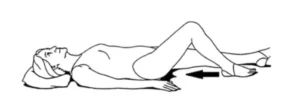If you are one of the millions of people who suffer from spinal stenosis, you know how debilitating it can be. The pain and numbness in your back and legs can make it difficult to do even the simplest things. Many people find relief from their symptoms through physical therapy exercises. In this blog post, we will discuss some of the best exercises for spinal stenosis. We will also provide a list of resources that can help you get started on your road to recovery!
Contents
What Is Spinal Stenosis?
 Spinal stenosis is a condition that narrows your spinal canal, which can put pressure on your spinal cord and the nerves that travel through your spine. This can cause pain, numbness, or weakness in your back, legs, or arms. Spinal stenosis is most common in people over age 50.
Spinal stenosis is a condition that narrows your spinal canal, which can put pressure on your spinal cord and the nerves that travel through your spine. This can cause pain, numbness, or weakness in your back, legs, or arms. Spinal stenosis is most common in people over age 50.
This condition is often caused by the wear-and-tear changes that happen in your spine as you age. These changes include the growth of bone spurs and the thickening of ligaments. Spinal stenosis can also be caused by arthritis or a herniated disc. If you have mild spinal stenosis, you might not have any symptoms.
More often, it leads to pain, numbness, or weakness that can get worse over time. If the condition is severe, it can even cause paralysis. Therefore, do not hesitate to seek medical help if you experience any of these symptoms.
What Are Some Physical Therapy Examples?
Physical therapy is a common treatment for spinal stenosis. A physical therapist can help relieve pain and improve mobility by stretching the muscles around the spine and strengthening the muscles that support the spine.
There are many different exercises that can be done to relieve pain and improve mobility in people with spinal stenosis. The following are some examples of exercises that may be recommended by a physical therapist:
Hamstring stretches
Hamstring muscles are located in the back of the thigh and can become tight in people with spinal stenosis. Stretching these muscles can help relieve pain and improve mobility. For example this hamstring stretch:
- Lie on your back with both legs straight.
- Loop a towel around your right foot and hold the ends of the towel in your hands.
- Keeping your left leg straight, raise your right leg up toward the ceiling as far as you can.
- Hold this position for 30 seconds and then repeat with the other leg.
Quadriceps stretches
The quadriceps are located in the front of the thigh and can also become tight in people with spinal stenosis. Stretching these muscles can help relieve pain and improve mobility. For example this quadriceps stretch:
- Stand up straight and hold onto a chair or countertop for support.
- Slowly bend one knee and bring your heel toward your buttock.
- Use your other hand to hold onto your ankle and pull it gently toward your body.
- You should feel a stretch in the front of your thigh.
- Hold the stretch for 30 seconds, then repeat on the other side.
Calf raises
Calf muscles are located in the back of the lower leg and can become very tight with spinal stenosis. To do a calf raise:
- Start by standing with your feet hip-width apart and your hands on a sturdy chair or counter for balance.
- Raise up onto your toes, then slowly lower back down.
- Repeat 10 times for one set. Do 2-3 sets per day.
Heel slides
 Heel slides stretch the calf muscles and help increase the range of motion in the ankle. This is a good exercise to do before trying calf raises. To do a heel slide:
Heel slides stretch the calf muscles and help increase the range of motion in the ankle. This is a good exercise to do before trying calf raises. To do a heel slide:
- Start by lying on your back with both legs straight and your hands at your sides.
- Slowly slide one leg straight out in front of you, keeping the other leg on the ground.
- Use your heel to stop when your leg is straight. You should feel a stretch in your calf.
- Hold for 30 seconds, then repeat with the other leg.
This is a type of physical therapy that can help you if you’re suffering from spinal stenosis. It can help to stretch the muscles and increase the range of motion in the affected areas. If you’re not sure how to do these exercises, or if you need more guidance, be sure to ask your physical therapist for help.
These are just a few options but there are many other exercises that can help too. The best way to find out is to talk with your physical therapist about what will work best for you. If you’re looking for relief from spinal stenosis, physical therapy may be a good option for you.
How Spinal Stenosis Physical Therapy Works?
It is not uncommon for older adults to experience some form of spinal stenosis. This is a narrowing of the spaces in the spine, which can put pressure on the spinal cord and nerves. This can cause pain, numbness, or weakness in the legs and back.
Spinal stenosis physical therapy is a form of treatment that can help to ease these symptoms and improve quality of life. Physical therapy exercises can help to stretch and strengthen the muscles around the spine, which can help to take pressure off of the nerves. In addition, physical therapy can help to improve flexibility and range of motion in the spine.
Moreover, it is important to keep in mind that spinal stenosis is a progressive condition. This means that it will continue to get worse over time. As such, it is important to start physical therapy as soon as possible. The sooner you start, the better your chances of seeing significant improvements.
If you are considering starting spinal stenosis physical therapy, it is important to speak with your doctor first. They can help to create a custom physical therapy plan that is tailored to your individual needs. This way, you can be sure that you are doing exercises that are safe and effective for you.
What Are The Benefits Of Spinal Stenosis Physical Therapy?
 There are many benefits to participating in spinal stenosis physical therapy. Some of the benefits include:
There are many benefits to participating in spinal stenosis physical therapy. Some of the benefits include:
- Reduced pain: It is common for those with spinal stenosis to experience pain in the lower back, buttocks, and legs. Physical therapy can help to reduce this pain by strengthening the muscles around the spine and improving flexibility.
- Improved mobility: Spinal stenosis can lead to stiffness in the affected area and difficulty moving. Physical therapy can help improve your range of motion and make it easier for you to move around.
- Prevention of further damage: Spinal stenosis can cause the discs in your spine to degenerate and become damaged. Physical therapy can help to prevent this by strengthening the muscles that support your spine.
- Improved strength: It is common for people with spinal stenosis to experience weakness in the affected area. Physical therapy can help improve your strength and make it easier for you to perform everyday tasks.
- Improved function: Spinal stenosis can make it difficult to perform everyday tasks such as walking, bending, and lifting. Physical therapy can help improve your function and make it easier for you to perform these tasks.
Overall, these are just a few of the many benefits that you can experience by participating in spinal stenosis physical therapy. If you are suffering from spinal stenosis, be sure to talk to your doctor about whether or not physical therapy is right for you. This can be an extremely effective treatment option for many people.
How To Get Started With Physical Therapy?
When starting with spinal stenosis physical therapy, your first step will be to consult with a licensed physical therapist. He or she will assess your individual condition and recommend an appropriate course of action. In some cases, your doctor may prescribe spinal stenosis physical therapy as a way to avoid surgery.
There are some tips to follow when beginning your physical therapy:
- Wear comfortable clothing that won’t restrict your movement.
- Be sure to warm up before starting your exercises.
- Start slowly and gradually increase the intensity of your workouts.
- Focus on good form to prevent injury.
- Listen to your body and stop if you feel any pain.
These things can help make your experience with physical therapy more positive and successful. Because when you’re finally pain-free, you’ll be so glad you made the effort!
Can Spinal Stenosis Be Prevented?
 Well, this is a tricky question. You see, most of the time spinal stenosis is caused by degenerative changes in the spine that happen over time due to aging or injury. So in most cases, it’s not possible to prevent it. However, there are things you can do to minimize your risk of developing spinal stenosis or of making it worse.
Well, this is a tricky question. You see, most of the time spinal stenosis is caused by degenerative changes in the spine that happen over time due to aging or injury. So in most cases, it’s not possible to prevent it. However, there are things you can do to minimize your risk of developing spinal stenosis or of making it worse.
For example, if you have a job that requires you to lift heavy objects, be sure to use proper lifting techniques. And if you’re obese, losing weight can help reduce the stress on your spine and may help prevent the onset of spinal stenosis.
In addition, there are some medical conditions that can increase your risk of developing spinal stenosis. These include:
- Degenerative disc disease
- Osteoarthritis
- Bone spurs
- Herniated discs
If you have one of these conditions, it’s important to manage it appropriately and to get regular checkups so that your doctor can monitor your spine and detect any changes early on.
Finally, if you’re a smoker, quitting smoking is one of the best things you can do for your overall health—including your spine. That’s because smoking contributes to degenerative changes in the spine and also decreases blood flow, which can make it harder for your spine to heal if it’s injured.
Conclusion
To conclude, spinal stenosis physical therapy is an excellent way to find relief from this condition. If you are looking for a way to reduce your pain and improve your mobility, these exercises may be just what you need. Be sure to talk to your doctor or physical therapist before starting any new exercise program, however, to be sure that it is safe for you to do so.
Moreover, you should understand that there is no one-size-fits-all solution to this problem. So, it is important to tailor the exercises according to your own needs and preferences. If you are not sure where to start, consider seeking professional help from a certified physical therapist.
Physical Therapy help patients recover from pain. If you’re experiencing Back pain, Shoulder pain, Knee pain, Neck pain, Elbow pain, Hip pain, or Arthritis pain, a physical therapist at MantraCare can help: Book a physiotherapy session.


